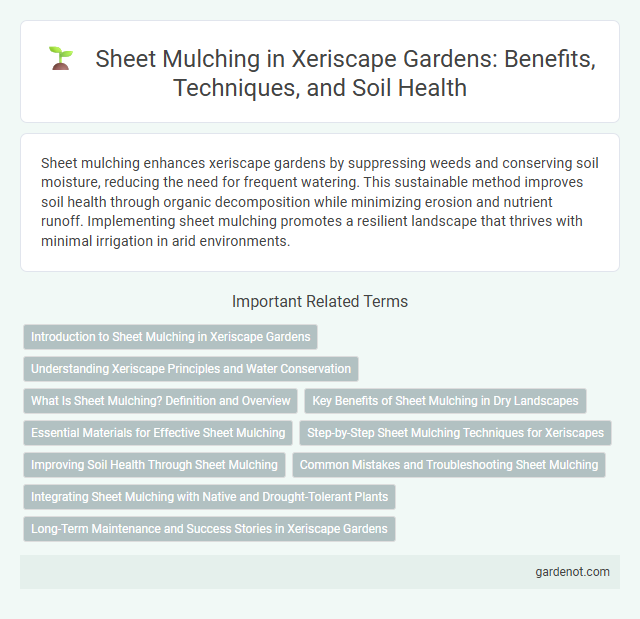Sheet mulching enhances xeriscape gardens by suppressing weeds and conserving soil moisture, reducing the need for frequent watering. This sustainable method improves soil health through organic decomposition while minimizing erosion and nutrient runoff. Implementing sheet mulching promotes a resilient landscape that thrives with minimal irrigation in arid environments.
Introduction to Sheet Mulching in Xeriscape Gardens
Sheet mulching is a sustainable gardening technique widely used in xeriscape landscapes to improve soil health and retain moisture. This method involves layering organic materials such as cardboard, compost, and mulch to suppress weeds and enhance water infiltration. By mimicking natural processes, sheet mulching reduces the need for irrigation and promotes drought-resistant plant growth in xeriscape gardens.
Understanding Xeriscape Principles and Water Conservation
Sheet mulching in xeriscape design enhances soil moisture retention by creating a protective layer that suppresses weeds and reduces evaporation. This technique aligns with xeriscape principles by improving water conservation, promoting healthy plant growth with minimal irrigation. Utilizing organic materials such as cardboard and mulch, sheet mulching supports sustainable landscaping practices in arid environments.
What Is Sheet Mulching? Definition and Overview
Sheet mulching is an eco-friendly gardening technique used in xeriscaping to improve soil health and retain moisture by layering organic materials directly over the soil. This method involves placing cardboard or newspaper to suppress weeds, followed by layers of compost, mulch, or straw, which decompose over time and enrich the soil. Commonly utilized in drought-resistant landscaping, sheet mulching reduces water usage while enhancing soil fertility and promoting sustainable plant growth.
Key Benefits of Sheet Mulching in Dry Landscapes
Sheet mulching conserves soil moisture by creating a moisture-retentive barrier that significantly reduces evaporation in dry landscapes. It improves soil fertility and structure through the gradual decomposition of organic layers, enhancing plant health without excessive watering. This technique effectively suppresses weeds, minimizing competition for water and nutrients in arid environments.
Essential Materials for Effective Sheet Mulching
Essential materials for effective sheet mulching in xeriscape gardening include organic layers such as cardboard or newspaper to suppress weeds, followed by a rich compost layer that enriches soil nutrients. A thick layer of mulch like wood chips or straw helps retain moisture and regulate soil temperature, crucial in drought-resistant landscapes. Incorporating natural soil amendments like gypsum or organic fertilizers further enhances soil structure and promotes healthy plant growth in xeriscaped areas.
Step-by-Step Sheet Mulching Techniques for Xeriscapes
Sheet mulching in xeriscapes involves layering organic materials to suppress weeds, retain soil moisture, and improve soil health. Start by clearing the area of existing vegetation, then lay down a water-permeable cardboard or newspaper base; apply a layer of compost or aged mulch, followed by a top layer of coarse mulch like wood chips. This method enhances soil structure, reduces irrigation needs, and supports drought-tolerant plant success in arid landscapes.
Improving Soil Health Through Sheet Mulching
Sheet mulching enhances soil health by layering organic materials such as cardboard, compost, and mulch to suppress weeds, retain moisture, and encourage beneficial microbial activity. This technique improves soil structure, increases nutrient availability, and promotes natural decomposition processes essential for xeriscape gardening. Incorporating sheet mulching in xeriscape landscapes reduces irrigation needs while fostering robust, resilient plant growth.
Common Mistakes and Troubleshooting Sheet Mulching
Common mistakes in sheet mulching include using non-biodegradable materials, failing to suppress weeds completely, and applying layers too thickly, which can hinder water penetration and root growth. Troubleshooting involves removing synthetic materials, ensuring proper soil moisture, and re-mulching with organic layers like cardboard and compost to improve soil health and weed control. Proper sheet mulching enhances xeriscape sustainability by promoting efficient water retention and reducing maintenance.
Integrating Sheet Mulching with Native and Drought-Tolerant Plants
Sheet mulching enhances soil moisture retention and weed suppression, creating an ideal environment for native and drought-tolerant plants in xeriscape gardens. This technique improves soil structure and nutrient availability, reducing the need for supplemental watering and fertilizers. By integrating sheet mulching with adapted plants, water conservation is maximized while promoting sustainable and low-maintenance landscapes.
Long-Term Maintenance and Success Stories in Xeriscape Gardens
Sheet mulching enhances soil structure and moisture retention, reducing water usage and weed growth in xeriscape gardens for sustainable, low-maintenance landscapes. Long-term maintenance involves periodic replenishment of organic layers and monitoring soil health to support plant vitality and resilience. Successful xeriscape projects in arid regions report up to 60% water savings and improved plant survival rates using sheet mulching techniques.
Sheet mulching Infographic

 gardenot.com
gardenot.com